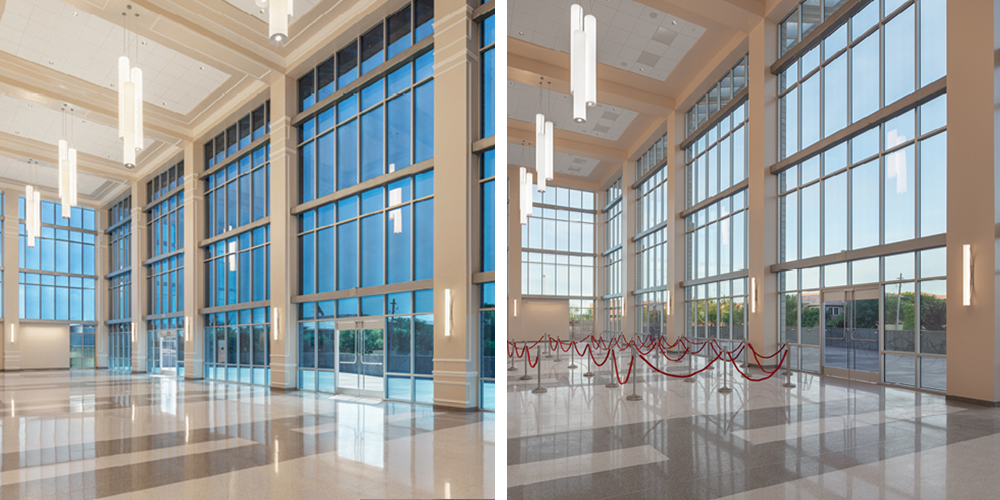Dynamic Glazing
Optical performance properties

Above: Example of electrochromic glazing in tinted state and clear state. Photos by SageGlass.
Note: This article is excerpted from NGA Glass Technical Paper FB32-24 Dynamic Glazing for High Performance Buildings
Dynamic glazing is a fenestration product that can change its optical performance properties, such as visible light transmission, near infrared transmission and solar heat gain coefficient. These properties can change based on exposure to different stimuli; some change in response to electrical stimulus (electrochromic), others change in response to absorbed sunlight (photochromic) and some respond to ambient or product temperature (thermochromic). Dynamic glazing can be designed to improve occupant comfort and/or energy performance by capturing useful daylight while controlling glare and unwanted solar heat gain.
Electrochromic glazing
An electrical stimulus is used to change the VLT and SHGC of electrochromic glass. The glass is generally formed by depositing distinct layers of transparent conductive oxides and other electrochromic materials onto a float glass substrate.
Tinting of the glass occurs with the application of a low-voltage direct current (less than 5 volts), which causes lithium ions to move from an ion-storage layer through an ion-conducting layer, into an electrochromic layer. The presence of ions causes this electrochromic layer to absorb visible light, ultraviolet and near infrared light, in proportion to the number of ions transferred, thus making the glass appear tinted. The glazing can be switched from a highly transparent state to a highly tinted state.
Electrochromic glass can be configured to respond to manual control or controlled automatically using sensors for light, temperature, occupancy or time of day.
Photochromic glass
Photochromic materials change their transparency in response to UV light. The glass can be made with integral photochromic compounds or a photochromic film that is laminated between or applied to glass. The main application of photochromic materials is in eyeglasses that change from clear in dim indoor light to dark in bright outdoors.
Liquid crystal glass
Liquid crystal glass is made by encapsulating a liquid-like layer in which organic particles are suspended between two sheets of either polyethylene terephthalate plastic, soda-lime glass or borosilicate glass. These sheets are coated with a transparent conducting oxide, then laminated between two lites of glass using two adhesive layers. Liquid crystal glass may be used as privacy glazing because it transitions from a translucent to transparent state. When power is off, the liquid crystals are in a random and unaligned state. They scatter light, which makes the glass appear translucent, thus obscuring direct views and providing privacy. When the voltage is applied, the crystals align, allowing light to pass through and thus appearing transparent.
The light transmission and the SHGC are not modulated in this product, since the light is scattered, not blocked, so it provides little energy or glare control performance. Therefore, this type of dynamic glazing is used most often for privacy in interior applications, such as bathrooms, conference rooms and changing rooms in retail stores.
Sunlight-activated (thermochromic) glass
Sunlight-activated glazing changes its VLT and SHGC properties based on absorbed sunlight, which changes the temperature of the glass. Sunlight-activated glazing is constructed with an extruded thermochromic polyvinyl butyral film. Additives in the film respond to increasing temperature to slowly vary the VLT and SHGC, as well as fading factors when laminated between two lites of glass and exposed to the sun.
Suspended particle device glass
In a similar way to liquid crystal glazing, suspended particle device, or SPD, glass is constructed using two electrically conductive coated plastic layers with an emulsion containing suspended particles placed between the plastic layers forming a film or sheet. This is then laminated between two lites of glass using two adhesive interlayers, one on either side of the plastic film. SPDs are electronically controlled to provide variable tinting. When voltage (approximately 80 volts) is applied to the SPD, the suspended particles align and allow light to flow through unhindered (the clear state). Once the electricity is turned off, the particles revert to a random pattern and block (absorb) light (the tinted state). In the tinted state, SPD only modulates the visible light. The near infrared is not blocked. SPD can be made in the form of a monolithic glass-plastic laminate, or this laminate can be incorporated into insulating glass units with the addition of a solar control low-emissivity glass for improved solar heat gain and insulation value.
Thermotropic glass
Thermotropic glazing is constructed with the active thermal component between lites of glass or plastic. There are three types of thermotropic glazing: reflective, absorbing and light scattering. The VLT of a thermotropic glazing changes when the ambient temperature exceeds a fixed activating temperature set point, so it is an “on-off” temperature activated technology. When this temperature threshold is exceeded, the VLT changes from a highly transparent state to a tinted reflective or light scattering state (depending on the type).
Task Group Volunteers
NGA thanks our task group volunteers for updating this resource: DJ Weil of Trulite, Kayla Natividad of Pilkington, Ted Derby of Intertek, Nicholas Koren of SageGlass, Tom Niziolek of Argotek, Rob Carlson of Tristar, Aaron Thompson of Viracon, Matt Kamper of Woodbridge Glass, and Abbie Legara of Aluminum and Glazing Lines.

